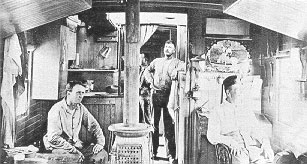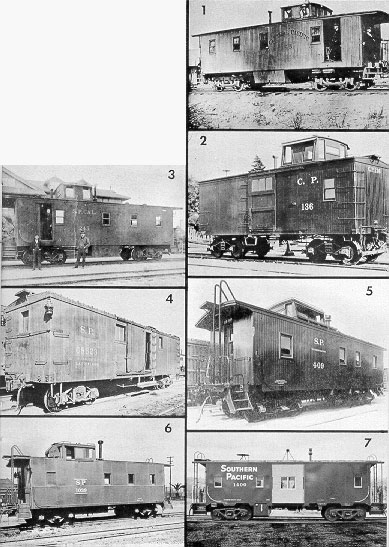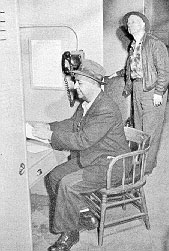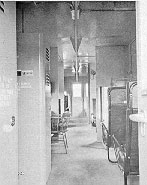Southern Pacific Bulletin
January, 1962, Page 22-26
The Wood Shanty Disappears;
Cabooses Have Become Symbolic Of Modern Railroading Techniques

The little wood shanty that used to trail faithfully after every string of freight cars-like many other railroad scenes-has undergone many changes in the past hundred years.
The box-like shelters train crews used to build to shield their cooking fires on spare platform cars in the mid 1800s, the converted box cars with sliding doors used around the turn of the century, the cupola-topped wooden cabooses popular after World War I, all have given way to ever more modern, efficient and better-equipped cabooses.
Today's SP caboose with its sleek bay windows of shatterproof glass, automatic oil heater, electric lights and refrigerator, drinking fountain, radio-telephone and specially-designed Pullman-type crew seats is fast becoming an operating symbol of the technological advances continually being made by SP. Rapidly disappearing are the old-fashioned hard benches and feather dusters, the coalbin and the kerosene lamp and the lazy board. The caboose has become a rolling office, efficient and functional, vastly different from its forebears. The origin of the caboose is un-certain. Even its birthdate is unknown. The most generally accepted story of its beginning is that a man named Nat Williams - a freight conductor on the Auburn & Syracuse Railroad during the 1830s - made it his custom to sit in the last car of a freight train on a box or barrel and direct the train's operation. As trains and runs grew longer, some railroads provided platform cars for their train crews, and eventually converted box cars for crews to use as shelters.
TWO THEORIES
Even the origin of the word caboose is disputed. Railroad his-torical authority D. L. Joslyn, a retired SP draftsman, documents its use back to the days of the early sailing vessels, when sailors customarily set up a fireplace or stove on ships' decks. To protect their fires and provide shelter for them-selves, seamen erected boxes over their fireplaces. These shelters were known to the Dutch as kabuis, to the Danes as kabys, the Swedes as kabysa, and Germans as kabuse.
Another theory holds that the word originated in Texas, Americanized from the Spanish word calabozo., meaning jailhouse. This idea, too, seems to have some merit.
In the eastern portion of the U.S., the car at the end of the train was called a "way car,"" "cabin car," "conductor's van," "accommodation car," "train car," "brakeman's cab," "shanty," or "crummy." Even today, many eastern railroads call them way cars, with a few referring to them as accommodation cars. Only in the West has the crew car been known almost universally as the caboose.
 (Photos at left) How the shanty grew up.
(Photos at left) How the shanty grew up.1- Central Pacific No. 45, built in August 1872 with wood frame trucks, could seat 22.
2- The 28-foot CP 136 cost $838 when built as a CP box car in 1885.
3- Proud crew had picture taken at Redding in their new caboose, August 1900.
4- Built in July 1898, this box car was converted to caboose in 1923.
5- Shiny when it was new in November 1907, No. 409 was wrecked in 1936.
6- Built at Los Angeles in July 1937, this was one of first all-steel cabooses on Pacific Lines.
7- Bay window cabooses were especially designed for crew comfort and safety-cost nearly $18,000 each.
CUPOLAS
The origin of the most distinguishing feature of cabooses-the "lookout" or cupola-has also been the subject of controversy, although a Chicago & North Western freight conductor seems to have settled the question. In 1898, T. B. Watson wrote "During the '60s I was a conductor on the C&NW. One day late in the summer of 1863 I received orders to give my caboose to the conductor of a construction train and take an empty boxcar to use as a caboose. This car happened to have a hole in the roof about two feet square. I stacked the lamp and tool boxes under the perforation end and sat with my head and shoulders above the roof... (Later) I suggested putting a box around the hole with glass in, so I could have a pilot house to sit in and watch the train."
Cupolas were first built into cabooses on the Central Pacific-SP's railroad ancestor-about 1875, and were permanent fixtures until 1949, when bay windows first made their appearance on SP cabooses. (The Akron, Canton & Youngstown Railroad is said to have been the first railroad to use the bay window, in 1923.)
CABOOSE WAS HOME
In the early days of railroading, each crew was assigned its own caboose, which served as home for days at a time. Some crews gave their rolling homes as much care as their wives gave to their permanent family residences, equipping them with such niceties as lace curtains, picturesque lithographs, their own mattresses and bed linen, easy chairs, even cook stoves. The culinary arts of some crews became legendary, with specialties ranging from hot cakes so light they had to be weighted down, to holiday feasts of roast turkey and trimmings.
As railroading grew more complex, and trains grew faster and went farther in shorter times, the caboose was no longer necessary to provide a home for extended periods. They were then assigned to the divisions, and crews rarely left their own districts.
In today's modern railroading techniques, the caboose pool has proved a very practical and economical advance. Pools have been established in SP's northern and southern districts - the Roseville-Northeast pool, with 140 cabooses, covers the territory from Roseville to Brooklyn and Eugene on the North, and to Ogden on the East. The Los Angeles-Southwest pool has 228 bay window cabooses in use between Roseville, San Francisco, Bakersfield, Los Angeles, El Paso and Tucumcari. Under the pool arrangement, a caboose stays with the freight train from the train's origin point until it reaches its destination (if on SP lines) or an interchange point with another railroad.
DESIGNED WITH CARE
The care and attention given to cabooses has come a long way from the days when Nat Williams sat on a barrel in the last car of his train and T. B. Watson got his orders to pick up an empty boxcar for his new caboose.
SP's newest cabooses - 200 all-steel cars with bay windows-were planned by car design engineers of the Mechanical Department, with the cooperation of the Operating and Safety Departments. A far cry from the ill-equipped caboose of old, today's modern cars cost near-ly $18,000 each to build.
Typical of the efforts made to modernize crew cars was the re-building of caboose SP-1000 in 1959. One of those constructed in 1937, SP-1000 received a complete remodeling in the Los Angeles General Shops and was equipped with the most up-to-date appliances. Then the car was used by crews between Los Angeles and El Paso, with the request that they evaluate the new equipment, and suggest further improvements. After the test runs, the car was taken to San Francisco, where it was inspected at the company's invitation by legislative representatives and general chairmen of the Order of Railway Conductors and Brakemen and the Brotherhood of Railway Trainmen, as well as by four staff members of the California Public Utilities Commission.
One of the most important advances made in modernizing cabooses, says Mechanical Department Engineer L. F. Bardoff, who helped design the new crew cars, "is the electrification program we began in 1954. We are continuing to install electrical systems so that eventually all cabooses used in pool service and long local runs will have electric marker lights, as well as desk and other interior lights. The electric refrigerators will be a help, too, in which to keep lunches and cold drinks on the hot runs."
M. A. Nugent, superintendent of safety, adds that the consideration given to the comfort, health and safety of crews is another important factor in our cabooses today. "The heavier drawbars and center sills," he says, "coupled with all-steel superstructure, window safety glass and nonskid floor paint have made our cabooses some of the finest-and safest-crew equipment on any railroad."

(Photo at left) Conductor Gillon H. Jones reads over his wheel report while Brakeman Cloyd Barker checks the air in one of the new bay window cabooses }ust before leaving Bayshore on the CLM for Los Angeles.

(Photo at left) Gleaming interior of new all-steel bay window caboose, looking toward B end. Note overhead grab iron running length of car, and rounded corners on steel lockers.
 Back to the Railway History Page
Back to the Railway History Page 